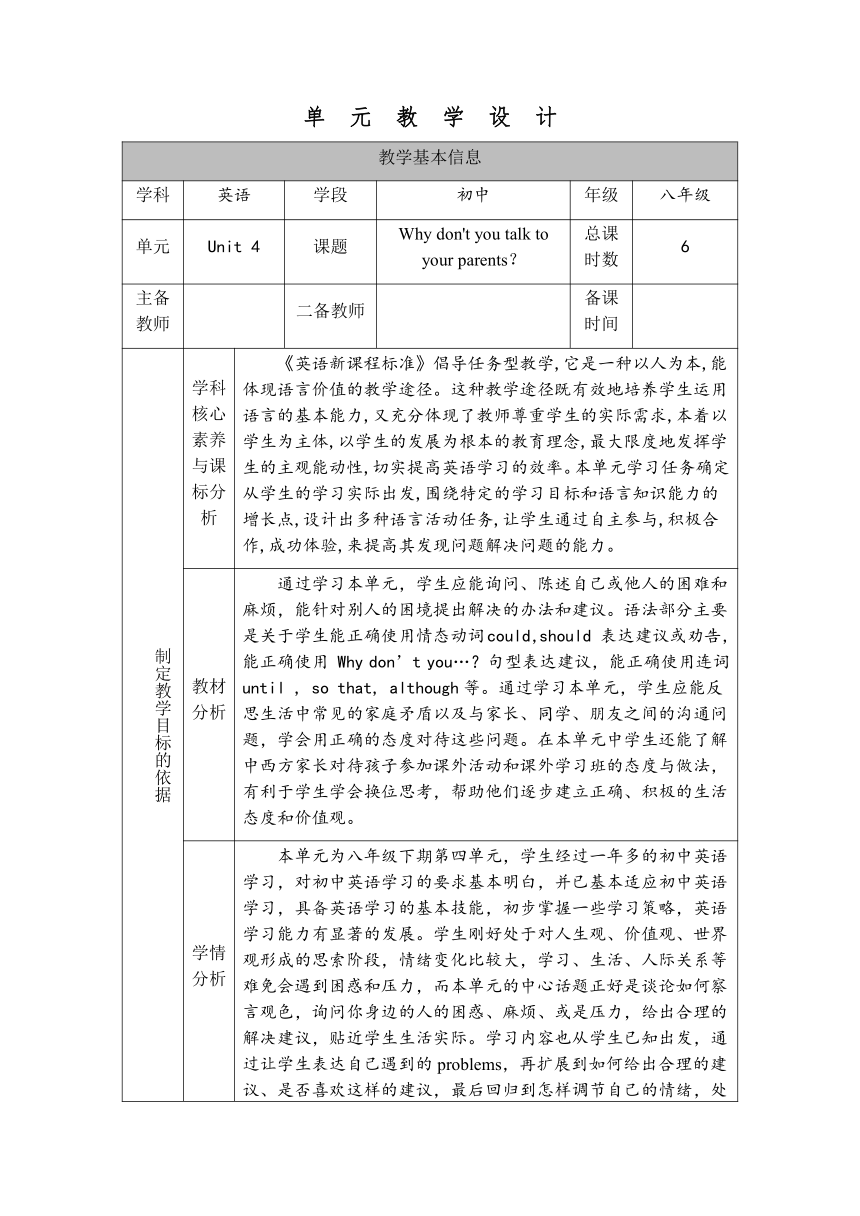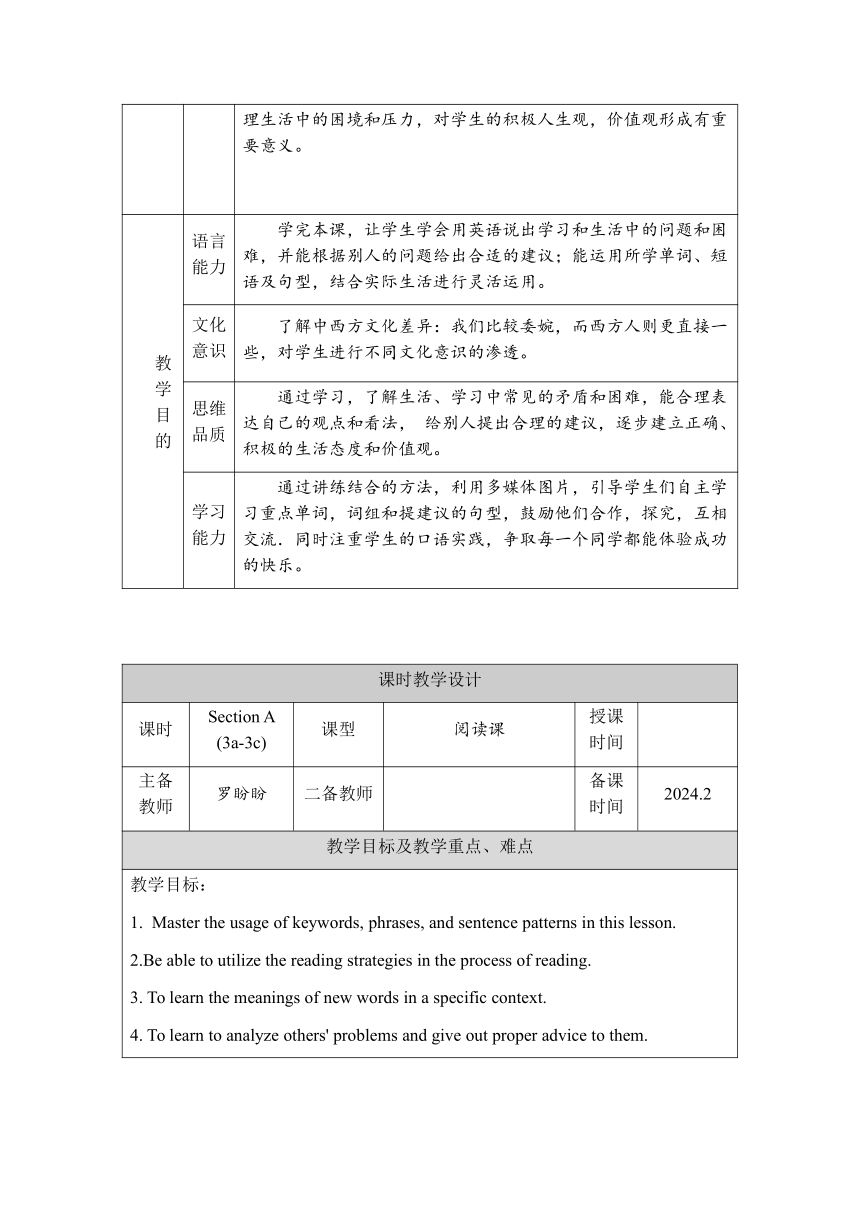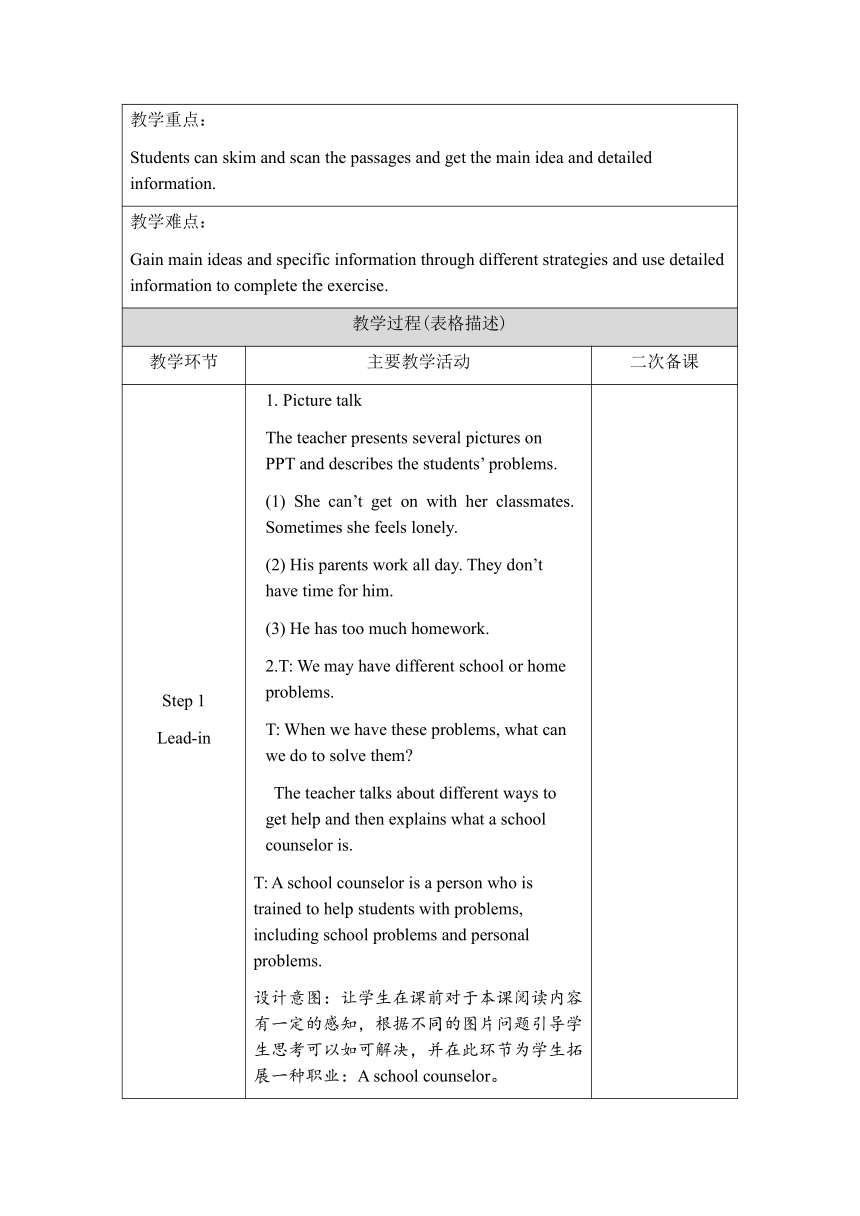Unit 4 Why don't you talk to your parents? Section A 3a-3c 教学设计(表格式2023-2024学年人教版英语八年级下册
文档属性
| 名称 | Unit 4 Why don't you talk to your parents? Section A 3a-3c 教学设计(表格式2023-2024学年人教版英语八年级下册 |

|
|
| 格式 | docx | ||
| 文件大小 | 298.2KB | ||
| 资源类型 | 教案 | ||
| 版本资源 | 人教新目标(Go for it)版 | ||
| 科目 | 英语 | ||
| 更新时间 | 2024-07-04 14:27:59 | ||
图片预览



文档简介
单 元 教 学 设 计
教学基本信息
学科 英语 学段 初中 年级 八年级
单元 Unit 4 课题 Why don't you talk to your parents? 总课时数 6
主备教师 二备教师 备课时间
制定教学目标的依据 学科核心素养与课标分析 《英语新课程标准》倡导任务型教学,它是一种以人为本,能体现语言价值的教学途径。这种教学途径既有效地培养学生运用语言的基本能力,又充分体现了教师尊重学生的实际需求,本着以学生为主体,以学生的发展为根本的教育理念,最大限度地发挥学生的主观能动性,切实提高英语学习的效率。本单元学习任务确定从学生的学习实际出发,围绕特定的学习目标和语言知识能力的增长点,设计出多种语言活动任务,让学生通过自主参与,积极合作,成功体验,来提高其发现问题解决问题的能力。
教材分析 通过学习本单元,学生应能询问、陈述自己或他人的困难和麻烦,能针对别人的困境提出解决的办法和建议。语法部分主要是关于学生能正确使用情态动词could,should 表达建议或劝告,能正确使用 Why don’t you…?句型表达建议,能正确使用连词until , so that, although等。通过学习本单元,学生应能反思生活中常见的家庭矛盾以及与家长、同学、朋友之间的沟通问题,学会用正确的态度对待这些问题。在本单元中学生还能了解中西方家长对待孩子参加课外活动和课外学习班的态度与做法,有利于学生学会换位思考,帮助他们逐步建立正确、积极的生活态度和价值观。
学情分析 本单元为八年级下期第四单元,学生经过一年多的初中英语学习,对初中英语学习的要求基本明白,并已基本适应初中英语学习,具备英语学习的基本技能,初步掌握一些学习策略,英语学习能力有显著的发展。学生刚好处于对人生观、价值观、世界观形成的思索阶段,情绪变化比较大,学习、生活、人际关系等难免会遇到困惑和压力,而本单元的中心话题正好是谈论如何察言观色,询问你身边的人的困惑、麻烦、或是压力,给出合理的解决建议,贴近学生生活实际。学习内容也从学生已知出发,通过让学生表达自己遇到的problems,再扩展到如何给出合理的建议、是否喜欢这样的建议,最后回归到怎样调节自己的情绪,处理生活中的困境和压力,对学生的积极人生观,价值观形成有重要意义。
教 学 目 的 语言能力 学完本课,让学生学会用英语说出学习和生活中的问题和困难,并能根据别人的问题给出合适的建议;能运用所学单词、短语及句型,结合实际生活进行灵活运用。
文化意识 了解中西方文化差异:我们比较委婉,而西方人则更直接一些,对学生进行不同文化意识的渗透。
思维品质 通过学习,了解生活、学习中常见的矛盾和困难,能合理表达自己的观点和看法, 给别人提出合理的建议,逐步建立正确、积极的生活态度和价值观。
学习能力 通过讲练结合的方法,利用多媒体图片,引导学生们自主学习重点单词,词组和提建议的句型,鼓励他们合作,探究,互相交流.同时注重学生的口语实践,争取每一个同学都能体验成功的快乐。
课时教学设计
课时 Section A (3a-3c) 课型 阅读课 授课时间
主备教师 罗盼盼 二备教师 备课时间 2024.2
教学目标及教学重点、难点
教学目标: Master the usage of keywords, phrases, and sentence patterns in this lesson. 2.Be able to utilize the reading strategies in the process of reading. 3. To learn the meanings of new words in a specific context. 4. To learn to analyze others' problems and give out proper advice to them.
教学重点: Students can skim and scan the passages and get the main idea and detailed information.
教学难点: Gain main ideas and specific information through different strategies and use detailed information to complete the exercise.
教学过程(表格描述)
教学环节 主要教学活动 二次备课
Step 1 Lead-in 1. Picture talk The teacher presents several pictures on PPT and describes the students’ problems. (1) She can’t get on with her classmates. Sometimes she feels lonely. (2) His parents work all day. They don’t have time for him. (3) He has too much homework. 2.T: We may have different school or home problems. T: When we have these problems, what can we do to solve them The teacher talks about different ways to get help and then explains what a school counselor is. T: A school counselor is a person who is trained to help students with problems, including school problems and personal problems. 设计意图:让学生在课前对于本课阅读内容有一定的感知,根据不同的图片问题引导学生思考可以如可解决,并在此环节为学生拓展一种职业:A school counselor。
Step 2 Pre-reading 1. Have Ss look at the instruction of 3a and the writers and receivers of two letters. Then have Ss predict the answers to the question below. Q1: Where do you usually find these letters Q2: Who do you think has a problem Q3: Who is giving advice 2. The teacher presents the passage's picture on PPT and asks Ss to predict what kind of problems “Sad and Thirteen” might have. T: What problems do you think “Sad and Thirteen” might have Ss: I guess... The teacher paraphrases what Ss said during the conversation and explains some new words. T: His parents often argue with each other. T: He will be nervous. T: He should have proper communication with his parents 设计意图:文本阅读前让学生根据问题对文本进行预测,并在此环节处理本课中会遇到的生词新词,为学生后面的阅读扫清障碍,降低阅读难度。
Step 3 While-reading Fast reading 1. Have Ss scan the two letters and finish the exercises below. Careful reading 1. Have Ss scan the first letter and complete the table bel 2. Have Ss scan the second letter and complete the table below. 设计意图:通过任务型阅读的方式,让学生学会在速读中把握文章主旨大意;在细读中学会把握文本细节内容。培养训练学生阅读策略和技巧。
Step 4 Post-reading 1. Discussion(Pair work) Have Ss work in pairs and have a discussion. T: Do you agree or disagree with Mr. Hunt's advice Why 2. Retell the second letter. 4. Finish the exercise in 3c. Have Ss find out the words or phrases in the letters that have the same or similar meanings as those shown in 3c. 5. Deep thinking. T: How should we get on with our family T: Firstly, Listen to each other. Secondly, Open your mind. Thirdly, Voice your true feelings—finally, Equal(平等) to each other. T: We may have problems or conflicts(冲突) with our parents, friends, or classmates. Face the problems bravely and learn to communicate with love. 设计意图:让学生在读后能够尝试复述文本关键信息;在深入思考环节对学生进行一个正向的引导,使学生学会如何正确与家人等相处,学会如何正确化解与他人间的矛盾。
Step 5 Summary Summarize the key content in this lesson. 设计意图:总结本课所学内容, 利用将思维导图给学生进行有序的梳理。
Step 7 Homework 1. Read and retell the passage. 2. Review the sentence patterns of giving advice we learnt in this unit. 3. Do the exercises. 设计意图:提高学生运用目标语言的能力。
板书设计 Unit 4 Why don't you talk to your parents? Section A (3a-3c) Problems: Advice: (sad and thirteen) (Robert Hunt) 1.parents fight a lot 1.talk about family 2.brother isn’t nice to me 2.offer to help 3.lonely and nervous 3.do more jobs
教学反思 本单元教材以“问题和建议”为中心话题。设计该阅读课时,从greeting, lead-in, pre-reading, while-reading到post-reading的各个环节中充分考虑到学生的综合能力培养。该课时在快读、细读及细节理解上有优势,力求让学生既能完整地理解课文,也能通过填空等形式充分把握文本细节内容。同时也将情感教育渗透在本阅读课中,通过文本主人公所面临的问题,同时启发引导学生如何正确处理自己与家人之间的关系。
教学基本信息
学科 英语 学段 初中 年级 八年级
单元 Unit 4 课题 Why don't you talk to your parents? 总课时数 6
主备教师 二备教师 备课时间
制定教学目标的依据 学科核心素养与课标分析 《英语新课程标准》倡导任务型教学,它是一种以人为本,能体现语言价值的教学途径。这种教学途径既有效地培养学生运用语言的基本能力,又充分体现了教师尊重学生的实际需求,本着以学生为主体,以学生的发展为根本的教育理念,最大限度地发挥学生的主观能动性,切实提高英语学习的效率。本单元学习任务确定从学生的学习实际出发,围绕特定的学习目标和语言知识能力的增长点,设计出多种语言活动任务,让学生通过自主参与,积极合作,成功体验,来提高其发现问题解决问题的能力。
教材分析 通过学习本单元,学生应能询问、陈述自己或他人的困难和麻烦,能针对别人的困境提出解决的办法和建议。语法部分主要是关于学生能正确使用情态动词could,should 表达建议或劝告,能正确使用 Why don’t you…?句型表达建议,能正确使用连词until , so that, although等。通过学习本单元,学生应能反思生活中常见的家庭矛盾以及与家长、同学、朋友之间的沟通问题,学会用正确的态度对待这些问题。在本单元中学生还能了解中西方家长对待孩子参加课外活动和课外学习班的态度与做法,有利于学生学会换位思考,帮助他们逐步建立正确、积极的生活态度和价值观。
学情分析 本单元为八年级下期第四单元,学生经过一年多的初中英语学习,对初中英语学习的要求基本明白,并已基本适应初中英语学习,具备英语学习的基本技能,初步掌握一些学习策略,英语学习能力有显著的发展。学生刚好处于对人生观、价值观、世界观形成的思索阶段,情绪变化比较大,学习、生活、人际关系等难免会遇到困惑和压力,而本单元的中心话题正好是谈论如何察言观色,询问你身边的人的困惑、麻烦、或是压力,给出合理的解决建议,贴近学生生活实际。学习内容也从学生已知出发,通过让学生表达自己遇到的problems,再扩展到如何给出合理的建议、是否喜欢这样的建议,最后回归到怎样调节自己的情绪,处理生活中的困境和压力,对学生的积极人生观,价值观形成有重要意义。
教 学 目 的 语言能力 学完本课,让学生学会用英语说出学习和生活中的问题和困难,并能根据别人的问题给出合适的建议;能运用所学单词、短语及句型,结合实际生活进行灵活运用。
文化意识 了解中西方文化差异:我们比较委婉,而西方人则更直接一些,对学生进行不同文化意识的渗透。
思维品质 通过学习,了解生活、学习中常见的矛盾和困难,能合理表达自己的观点和看法, 给别人提出合理的建议,逐步建立正确、积极的生活态度和价值观。
学习能力 通过讲练结合的方法,利用多媒体图片,引导学生们自主学习重点单词,词组和提建议的句型,鼓励他们合作,探究,互相交流.同时注重学生的口语实践,争取每一个同学都能体验成功的快乐。
课时教学设计
课时 Section A (3a-3c) 课型 阅读课 授课时间
主备教师 罗盼盼 二备教师 备课时间 2024.2
教学目标及教学重点、难点
教学目标: Master the usage of keywords, phrases, and sentence patterns in this lesson. 2.Be able to utilize the reading strategies in the process of reading. 3. To learn the meanings of new words in a specific context. 4. To learn to analyze others' problems and give out proper advice to them.
教学重点: Students can skim and scan the passages and get the main idea and detailed information.
教学难点: Gain main ideas and specific information through different strategies and use detailed information to complete the exercise.
教学过程(表格描述)
教学环节 主要教学活动 二次备课
Step 1 Lead-in 1. Picture talk The teacher presents several pictures on PPT and describes the students’ problems. (1) She can’t get on with her classmates. Sometimes she feels lonely. (2) His parents work all day. They don’t have time for him. (3) He has too much homework. 2.T: We may have different school or home problems. T: When we have these problems, what can we do to solve them The teacher talks about different ways to get help and then explains what a school counselor is. T: A school counselor is a person who is trained to help students with problems, including school problems and personal problems. 设计意图:让学生在课前对于本课阅读内容有一定的感知,根据不同的图片问题引导学生思考可以如可解决,并在此环节为学生拓展一种职业:A school counselor。
Step 2 Pre-reading 1. Have Ss look at the instruction of 3a and the writers and receivers of two letters. Then have Ss predict the answers to the question below. Q1: Where do you usually find these letters Q2: Who do you think has a problem Q3: Who is giving advice 2. The teacher presents the passage's picture on PPT and asks Ss to predict what kind of problems “Sad and Thirteen” might have. T: What problems do you think “Sad and Thirteen” might have Ss: I guess... The teacher paraphrases what Ss said during the conversation and explains some new words. T: His parents often argue with each other. T: He will be nervous. T: He should have proper communication with his parents 设计意图:文本阅读前让学生根据问题对文本进行预测,并在此环节处理本课中会遇到的生词新词,为学生后面的阅读扫清障碍,降低阅读难度。
Step 3 While-reading Fast reading 1. Have Ss scan the two letters and finish the exercises below. Careful reading 1. Have Ss scan the first letter and complete the table bel 2. Have Ss scan the second letter and complete the table below. 设计意图:通过任务型阅读的方式,让学生学会在速读中把握文章主旨大意;在细读中学会把握文本细节内容。培养训练学生阅读策略和技巧。
Step 4 Post-reading 1. Discussion(Pair work) Have Ss work in pairs and have a discussion. T: Do you agree or disagree with Mr. Hunt's advice Why 2. Retell the second letter. 4. Finish the exercise in 3c. Have Ss find out the words or phrases in the letters that have the same or similar meanings as those shown in 3c. 5. Deep thinking. T: How should we get on with our family T: Firstly, Listen to each other. Secondly, Open your mind. Thirdly, Voice your true feelings—finally, Equal(平等) to each other. T: We may have problems or conflicts(冲突) with our parents, friends, or classmates. Face the problems bravely and learn to communicate with love. 设计意图:让学生在读后能够尝试复述文本关键信息;在深入思考环节对学生进行一个正向的引导,使学生学会如何正确与家人等相处,学会如何正确化解与他人间的矛盾。
Step 5 Summary Summarize the key content in this lesson. 设计意图:总结本课所学内容, 利用将思维导图给学生进行有序的梳理。
Step 7 Homework 1. Read and retell the passage. 2. Review the sentence patterns of giving advice we learnt in this unit. 3. Do the exercises. 设计意图:提高学生运用目标语言的能力。
板书设计 Unit 4 Why don't you talk to your parents? Section A (3a-3c) Problems: Advice: (sad and thirteen) (Robert Hunt) 1.parents fight a lot 1.talk about family 2.brother isn’t nice to me 2.offer to help 3.lonely and nervous 3.do more jobs
教学反思 本单元教材以“问题和建议”为中心话题。设计该阅读课时,从greeting, lead-in, pre-reading, while-reading到post-reading的各个环节中充分考虑到学生的综合能力培养。该课时在快读、细读及细节理解上有优势,力求让学生既能完整地理解课文,也能通过填空等形式充分把握文本细节内容。同时也将情感教育渗透在本阅读课中,通过文本主人公所面临的问题,同时启发引导学生如何正确处理自己与家人之间的关系。
同课章节目录
- Unit 1 What's the matter?
- Section A
- Section B
- Unit 2 I'll help to clean up the city parks.
- Section A
- Section B
- Unit 3 Could you please clean your room?
- Section A
- Section B
- Unit 4 Why don't you talk to your parents?
- Section A
- Section B
- Unit 5 What were you doing when the rainstorm came
- Section A
- Section B
- Review of Units 1-5
- Unit 6 An old man tried to move the mountains.
- Section A
- Section B
- Unit 7 What's the highest mountain in the world?
- Section A
- Section B
- Unit 8 Have you read Treasure Island yet?
- Section A
- Section B
- Unit 9 Have you ever been to a museum?
- Section A
- Section B
- Unit 10 I've had this bike for three years.
- Section A
- Section B
